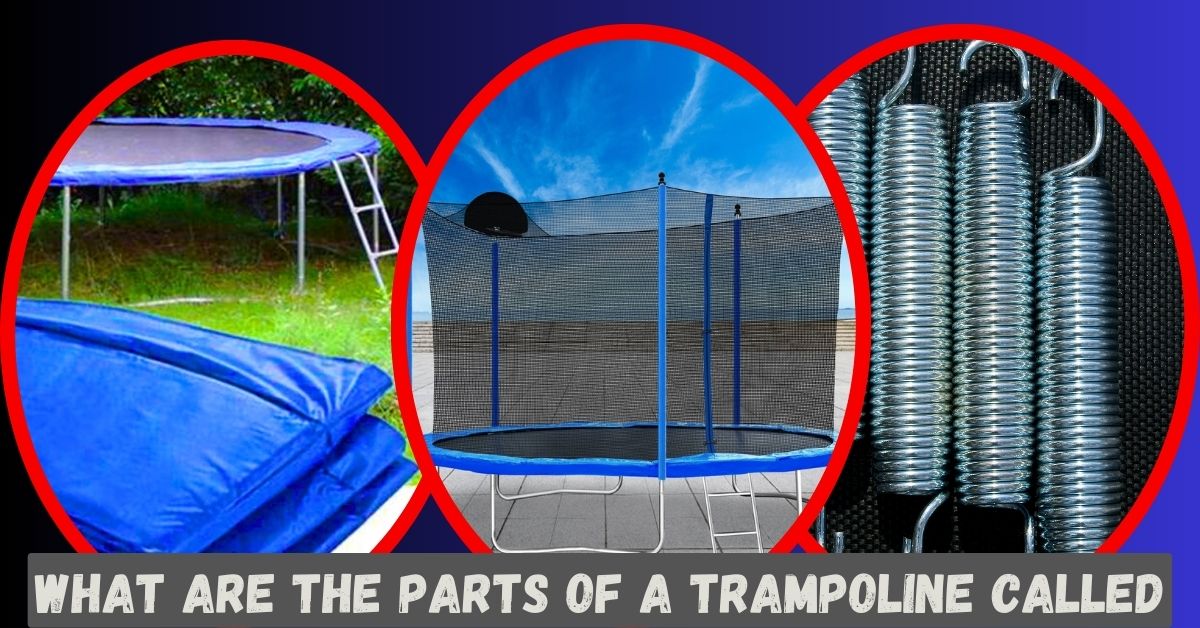Do you know “what are the parts of a trampoline called?” Trampolines are an excellent addition to our family time, offering a wonderful way for us to bond and enjoy each other’s company.
Not only do they bring joy and laughter, but they also provide an opportunity to engage in outdoor activities and stay active.
I found trampolines incredibly exciting, and now as an adult, I still appreciate the thrill they offer. Exploring the inner workings of a trampoline has been fascinating. It’s incredible to see how each part contributes to its functionality.
Every component plays a crucial role, from the frame that provides stability to the springs that create the bouncing effect. The mat, safety pad, enclosure net, ladder, and anchoring system are all essential elements that ensure both fun and safety.
Taking care of a trampoline, including regular maintenance and storage, is important to prolong its lifespan and keep everyone safe. With a trampoline, we can create lasting memories while staying active together.
What are the Parts of a Trampoline Called: The parts of a trampoline include the frame, springs, mat, safety pad, enclosure net, ladder (optional), and anchoring system (optional).
What are the Parts of a Trampoline Called?
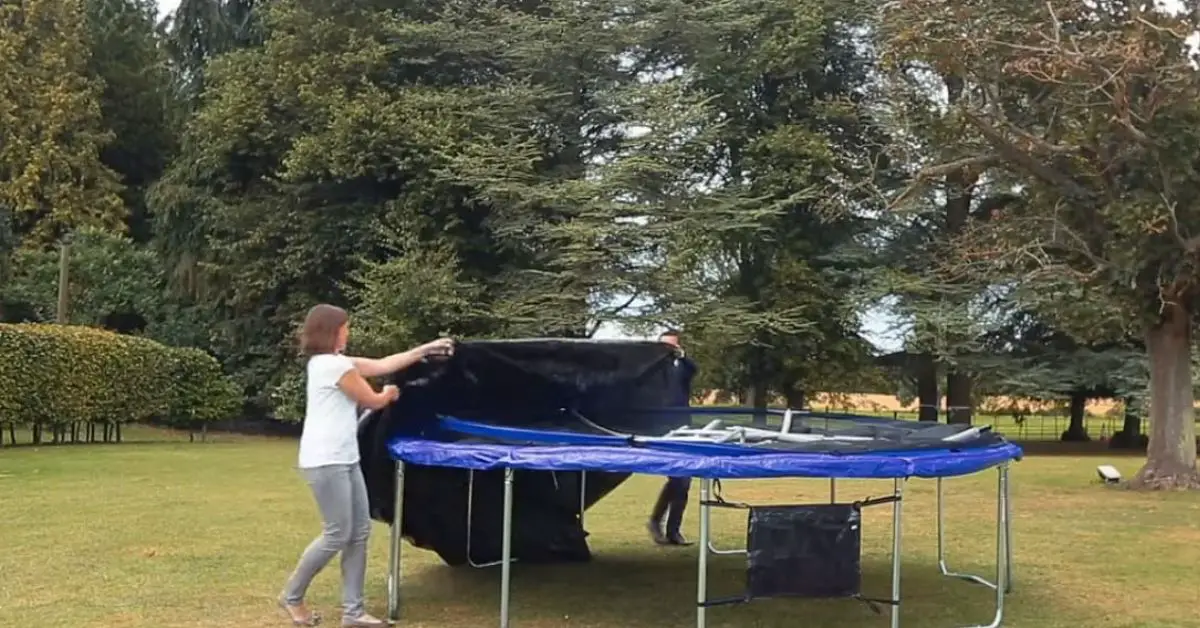
A trampoline comprises several parts that work together to provide a fun and safe jumping experience. The main parts of a trampoline are the frame, springs, mat, enclosure net, safety padding, ladder, and anchor kit. In this article, we will discuss different parts of the trampoline in detail.
Different Parts of Trampoline:
Trampolines have different parts that are important to know. Some parts are necessary for the trampoline to work, while others are optional. The essential parts are the frame, springs, and mat.
These are crucial for the trampoline to function properly. Without them, the trampoline couldn’t provide a bouncing surface.
Understanding Trampoline Springs:
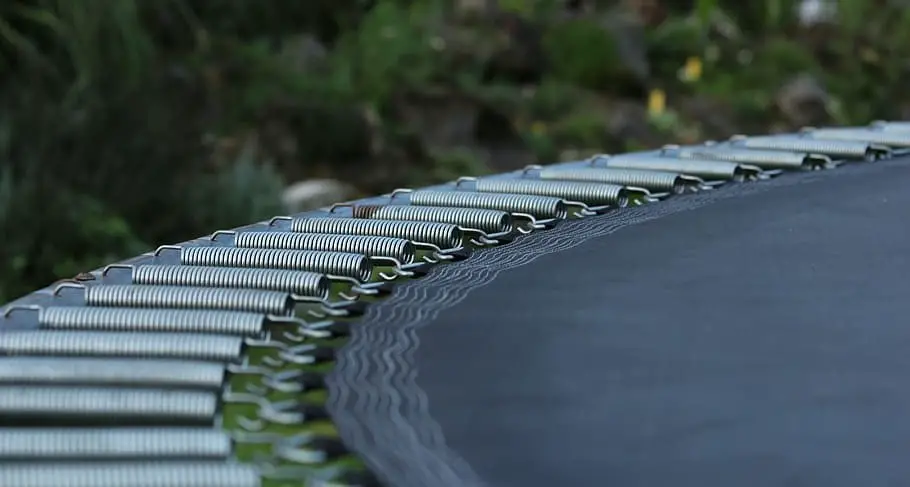
Trampoline springs are an important part of both safety and fun when using a trampoline. They are responsible for the bouncy feeling you get when jumping.
Choosing the right size springs when replacing them is essential, as they come in different lengths.
Trampoline springs can be made of different materials like steel, elastic straps, or even fiberglass rods. Having some extra springs at home is a good idea, as they are important for the trampoline’s overall performance.
It’s important to regularly check the springs and replace them if they don’t bounce back to their original shape.
Understanding the Trampoline Mat:
The trampoline mat is the part of the trampoline that gets the most use. It is typically made of strong fabric, like woven polypropylene or waterproof canvas. Taking good care of the mat is important, and using a trampoline cover can help protect it from the weather and harmful UV rays.
One area that may show wear and tear is the stitching, which is usually coated with UV protection but can wear off over time. High-quality mats should feel smooth and not be hard to jump on.
They come in different sizes, such as 8ft, 10ft, 12ft, 14ft, and 15ft. Investing in a good quality mat, like the ones from Permatron, is recommended for a better trampoline experience.
Exploring the Trampoline Enclosure Net:
Installing a trampoline enclosure is a simple and effective way to prevent injuries. The enclosure consists of a net that surrounds the trampoline, keeping users from falling off.
Falling off the trampoline is a common cause of accidents and injuries. If your trampoline enclosure gets damaged, you can buy replacement parts separately, so check availability.
It’s important to never allow your child to jump on a trampoline without a safety net in place.
Understanding the Trampoline Ladder:
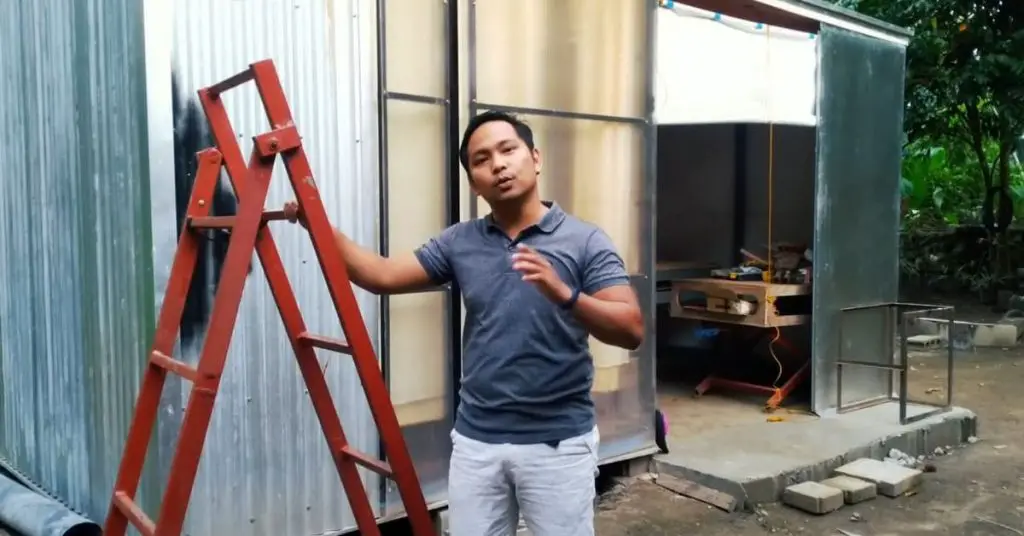
A trampoline ladder is a convenient addition to make your trampoline more accessible, particularly for toddlers and smaller children who may struggle to climb onto a trampoline due to its height, typically around 4 feet.
Providing an easier and safer way to get on and off the trampoline, the ladder ensures that children can enjoy their jumping experience easily.
It eliminates their need to struggle or potentially injure themselves while trying to access the trampoline.
With a trampoline ladder, kids can confidently and securely enter and exit the trampoline, enhancing their overall enjoyment and safety.
Understanding the Trampoline Frame:
The trampoline frame serves as the sturdy base of the trampoline. It consists of horizontal and vertical legs and a top rail, providing stability.
Depending on the size, trampoline frames can have 4 legs for medium-sized trampolines or 5-6 legs for larger ones. Most frames are made of strong, heavy gauge steel.
The frame is typically the longest-lasting part of a trampoline, and manufacturers often offer warranties of ten years or even a lifetime for the frame. However, finding specific trampoline frame parts can be challenging if the warranty has expired and you need to repair the frame.
In some cases, you might have to replace the entire frame, which can be difficult since frame replacements are not readily available. It is advisable to purchase a trampoline from a reputable brand that offers spare parts to ensure easier repairs in the future.
Understanding the Trampoline Collar:
The trampoline collar, or the spring cover, serves two important purposes. Firstly, it protects users from coming into direct contact with the springs, ensuring their safety.
Secondly, it safeguards the springs from damage caused by rust and wear. The collar prevents potential injuries that may occur if someone’s leg gets stuck in the gaps between the springs.
It is particularly beneficial for trampolines with an outer net, as it enhances safety and expands the play area. The collar is often made with foam, providing users with a pleasant and comfortable touch.
Understanding Trampoline Pads:
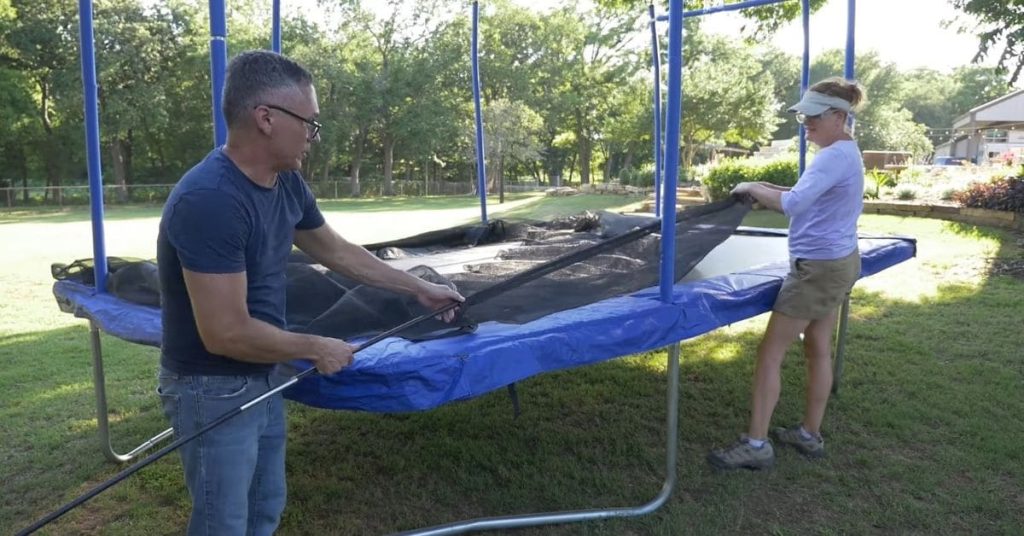
Trampoline pads are protective covers that cover your trampoline’s springs and outer frame. They are a cushioning layer in case someone accidentally falls on the springs or frame.
The main expectation from these pads is that they should be soft and comfortable. Additionally, you can choose them in a color that you love.
Since trampoline pads are often used, they often require frequent replacement. You can find replacement pads in various trampoline parts stores, including online platforms like Amazon.com.
Understanding Trampoline Posts and Safety Poles:
Trampoline posts, also known as safety poles, are the outermost parts of the trampoline that help keep the frame upright. They support the net of the trampoline, ensuring that users are protected from falling off.
These posts are typically sturdy tubes covered with a soft sponge. The sponge is a cushion if a child accidentally comes into contact with the post while jumping. Mushrooms are attachments that can be placed on the posts.
They allow the internal mesh of the trampoline to be securely attached to the posts, enhancing the overall safety and stability of the trampoline enclosure.
Exploring Additional Trampoline Accessories:
Several other accessories are important for the proper functioning of a trampoline. These include the top rail, anchors, and spring hooks. The top rail, also known as the upper ring, supports the trampoline structure and helps ensure proper net tension.
Anchors, also called herrings, are used to securely attach the trampoline to the ground, providing stability and preventing it from moving or tipping over.
Spring hooks are tools used for winding the springs, making it easier to attach them to the trampoline frame. These accessories play a role in enhancing the safety and performance of the trampoline.
Trampoline Skirt, Lower Trampoline Netting, and Trampoline Net:
A trampoline safety skirt is a part made of the same netting material as the trampoline net. It is designed to go around the lower part of the trampoline, specifically around the legs, and attaches to the frame using ties or bungees.
The purpose of the skirt is to create a barrier to prevent toddlers from going under the trampoline while older kids are jumping. It helps keep toddlers safe by preventing them from being accidentally weighed down by the jumping force of older kids on their heads, neck, and shoulders.
Additionally, the skirt adds a tidy finishing touch to the trampoline’s appearance. However, it can be a bit inconvenient when it’s time to mow the lawn around the trampoline.
Anchoring System:
The anchoring system for a trampoline is an optional accessory that is used to secure the trampoline to the ground. Its main purpose is to enhance stability and safety during use, especially in areas with strong winds or uneven ground.
Main Components of the Anchoring System:
- Anchor Straps or Stakes: These straps or stakes are driven into the ground around the trampoline. They provide the anchor points for securing the trampoline.
- Attachment Points on the Frame: The trampoline frame has specific attachment points where the anchor straps or stakes can be connected.
- Tensioning Mechanisms: Tensioning mechanisms, such as buckles or ratchets, are used to tighten the anchor straps and ensure a secure connection between the trampoline and the ground.
An anchoring system adds an extra layer of stability to the trampoline, minimizing the risk of it tipping over or shifting during use. This is particularly important in areas prone to strong winds.
Properly securing the trampoline with an anchoring system also reduces the likelihood of accidents or injuries caused by the trampoline moving unexpectedly.
When choosing an anchoring system, it is important to consider the specific requirements of your trampoline and the environment in which it will be used.
Follow the manufacturer’s instructions for installation and regularly inspect the anchoring system to ensure it remains secure.
What is the Middle of a Trampoline Called?
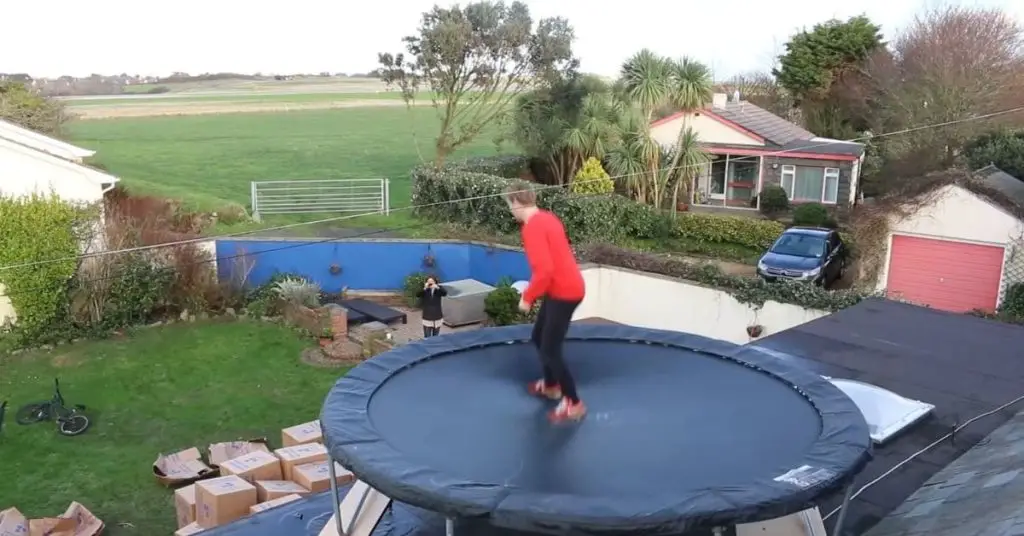
The middle of a trampoline is commonly known as the “jumping area” or “bounce zone.” The central section of the trampoline’s surface is where users jump and perform various activities.
This area is specifically designed to provide a springy and responsive surface for users to bounce on.
The jumping area is typically located between the outer edges of the trampoline and is surrounded by safety padding or a safety enclosure net. It is where users generate upward momentum by exerting force on the trampoline’s surface through their feet, resulting in a bouncing effect.
The construction of the jumping area involves the trampoline mat, which is made of durable materials such as woven polypropylene or waterproof canvas fabric.
The mat is securely attached to the trampoline frame and is responsible for providing the necessary elasticity and rebounding effect.
The middle or jumping area of the trampoline is the focal point of recreational activities and exercises on the trampoline. It is where users can engage in various movements, such as jumping, flipping, twisting, and performing tricks.
This area offers a thrilling and enjoyable experience, allowing users to experience the sensation of weightlessness and increased height as they propel themselves upward with each bounce.
Safety is paramount in the jumping area, and following guidelines and precautions to minimize the risk of injury is essential. Users should ensure that the trampoline is in good condition, with proper padding, a securely attached mat, and a well-maintained frame.
Additionally, adhering to weight limits and using the trampoline within the recommended guidelines will help promote a safe and enjoyable experience in the middle or jumping area of the trampoline.
What is the Bouncy Part of a Trampoline Called?
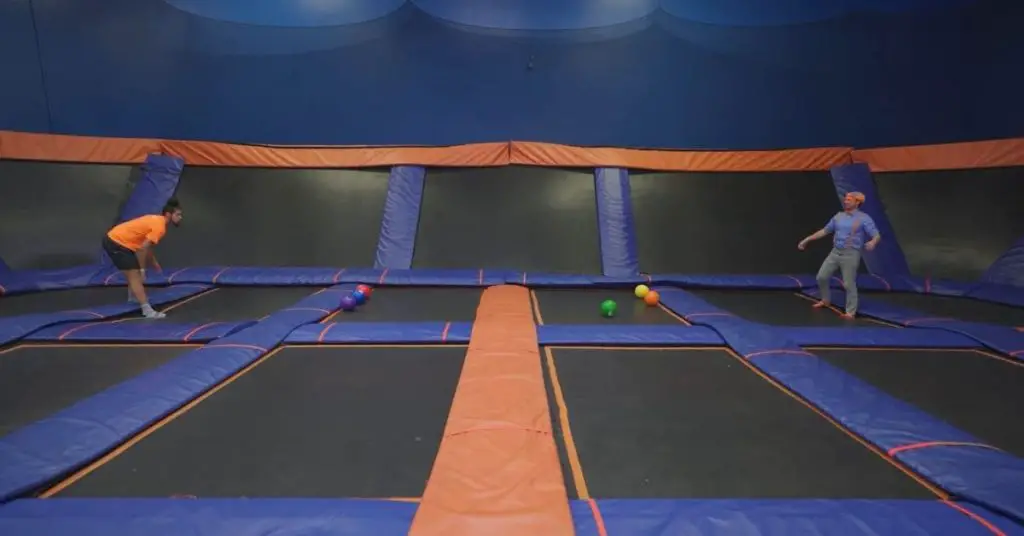
The bouncy part of a trampoline is called the “trampoline bed” or “jumping surface.” It refers to the area where users bounce and perform various movements on the trampoline.
The trampoline bed typically consists of a strong, elastic fabric called the trampoline mat, which is securely attached to the trampoline frame using springs or other tensioning mechanisms.
The trampoline bed is designed to provide a responsive, springy surface that allows users to generate upward momentum and experience the bouncing effect when they jump or exert force on the mat.
It is the central area where users engage in recreational activities, exercise, and have fun on the trampoline.
Maintenance and Care
Maintenance and care are essential for ensuring a trampoline’s longevity, safety, and optimal performance. Regular maintenance and proper care can help prevent accidents, extend the lifespan of the trampoline, and maintain its functionality.
Here are some important aspects to consider:
- Inspections: Regularly inspect the trampoline to identify any signs of wear, damage, or loose parts. Thoroughly check the frame, springs, mat, safety padding, and enclosure netting for tears, rust, or other issues that may compromise safety.
- Cleaning: Keep the trampoline clean by frequently removing debris, leaves, dirt, and other foreign objects from both the jumping area and the surrounding vicinity. Use a soft brush or cloth to clean the frame, mat, and safety padding. Avoid using harsh chemicals that may cause damage.
- Weather Protection: Safeguard the trampoline from harsh weather conditions. If feasible, disassemble and store the trampoline indoors during severe weather events like storms, heavy rain, snow, or strong winds. If indoor storage is impossible, consider utilizing a weather-resistant cover to shield the trampoline from UV rays, rain, and other elements.
- Spring Maintenance: Regularly inspect the springs to ensure they are intact and properly tensioned. Promptly replace any damaged or worn-out springs.
Follow the manufacturer’s guidelines to lubricate the trampoline’s springs and other movable parts for smooth and safe performance.
- Safety Features: Routinely check the safety padding and enclosure netting for any tears or damage. Ensure they are securely fastened to the frame and offer adequate protection. Immediately replace any compromised safety components to maintain a safe trampoline environment.
- Weight Limits: Adhere to the weight limits specified by the manufacturer to prevent excessive stress on the trampoline components and minimize the risk of accidents.
- Usage Guidelines: Strictly follow the manufacturer’s guidelines and recommendations for proper trampoline usage. Educate all users, particularly children, about safe trampoline practices, including prohibiting somersaults, allowing only one person at a time, and avoiding risky maneuvers.
- Regular Maintenance: Consider establishing a regular maintenance routine that includes tasks like periodically tightening bolts, checking tension, and adjusting the trampoline’s position if necessary.
By diligently following these maintenance and care practices, trampoline owners can ensure a safer and more enjoyable experience while maximizing the lifespan of their equipment.
Always refer to the manufacturer’s specific maintenance instructions and recommendations for comprehensive guidance.
Anchor Kit
Finally, we will talk about the anchor kit:
Definition and Purpose
An anchor kit is an optional accessory for trampolines, and its primary purpose is to enhance stability and safety. Essentially, it serves to secure the trampoline to the ground, minimizing the risk of tipping over or moving during use.
Types of Anchor Kits
Here are some types of anchor kit:
1. Ground Stakes:
Ground stakes are elongated, robust metal components that are typically driven into the ground around the trampoline’s frame. Their function is to enhance stability by anchoring the trampoline directly to the earth.
2. Auger-Style Anchors:
Auger-style anchors take on a corkscrew shape and are designed to be screwed into the ground, providing a particularly strong hold. They are often preferred for their secure anchoring, especially in softer or looser soil conditions.
3. Weighted Sandbags:
Weighted sandbags consist of bags filled with heavy materials, such as sand or gravel. These bags are strategically placed on the trampoline’s frame or legs to add weight and thus prevent unintended movement during use.
4. Spiral Tie-Downs:
Spiral tie-downs are anchor systems with a spiral shape, allowing them to be twisted or screwed into the ground. These anchors are connected to the trampoline frame using straps. Spiral tie-downs offer a combination of the benefits of ground stakes and strap systems, providing stability and flexibility.
5. Strap and Buckle Systems:
Strap and buckle systems involve securing the trampoline to the ground through the use of heavy-duty straps and sturdy buckles. These systems are adjustable, allowing for precise tensioning to ensure stability.
Installation and Securing
Trampoline Proper installation of an anchor kit entails the even placement of anchor points around the trampoline’s frame or legs.
It is crucial to adhere to the manufacturer’s specific instructions for anchor kit installation. This ensures that the anchors are securely fastened both to the ground and the trampoline frame, with no slack in the straps.
Use in Windy or Unstable Conditions
Anchor kits become especially vital during adverse weather conditions, particularly when it’s windy or when stability is compromised. They play a crucial role in preventing the trampoline from tipping over or being carried away by strong winds.
Regularly monitoring and adjusting the tension of the anchor kit is essential for maintaining the trampoline’s stability, especially during challenging weather conditions.
FAQs:
Q:1 What are the essential parts of a trampoline?
The essential parts of a trampoline include the frame, springs, and mat. These components work together to provide the bouncing experience.
Q:2 What is the purpose of the trampoline frame?
The frame is the structural backbone of the trampoline, providing stability and support. It is typically made of heavy gauge steel and holds all the other components in place.
Q:3 What do trampoline springs do?
Trampoline springs are responsible for creating the bounce. They connect the mat to the frame and store potential energy when compressed, which is released when a user jumps, resulting in upward force and bouncing motion.
Q:4 What is the role of the trampoline mat?
The trampoline mat is the surface on which users jump. It is usually made of woven polypropylene or waterproof canvas fabric that is strong and durable. The mat provides the jumping area and works in conjunction with the springs to generate the bounce.
Q:5 What is the purpose of the trampoline net or enclosure?
The trampoline net or enclosure is a safety feature that prevents users from falling off the trampoline. It surrounds the jumping area and is typically made of strong, UV-resistant materials. The netting is attached to the frame and helps ensure a secure and protected jumping environment.
Q:6 What are trampoline pads used for?
Trampoline pads, also known as safety pads, cover the springs and the outer frame of the trampoline. They provide a cushioned layer of protection, reducing the risk of injuries if someone falls on the springs or frame. Trampoline pads should be soft and in good condition for optimal safety.
Q:7 Are there any additional accessories for trampolines?
Additional accessories are available for trampolines, such as ladders for easy access, weather covers for protection against the elements, anchor kits for stability, and skirts or lower netting to prevent small children from crawling under the trampoline.
These accessories can enhance safety, convenience, and overall trampoline experience.
Conclusion:
In conclusion, understanding the various parts of a trampoline is essential for trampoline owners and users. The main components of a trampoline include the frame, springs, mat, and enclosure net.
The frame provides structural support and stability, while the springs and mat work together to create the bouncing effect. The enclosure net or trampoline netting is a vital safety feature that prevents users from falling off the trampoline.
Additionally, trampoline pads provide cushioning and protect users from contact with the springs and frame. Other accessories like ladders, weather covers, anchor kits, and skirts offer convenience, weather protection, stability, and safety enhancements.
By knowing the names and functions of these trampoline parts, users can better understand how the trampoline works and ensure proper maintenance and care.
Regular inspections, cleaning, and adherence to weight limits are crucial for maintaining safety and maximizing the lifespan of the trampoline.
Always refer to the manufacturer’s guidelines and instructions for specific details about your trampoline’s parts and maintenance requirements. With proper knowledge and care, you can enjoy a safe and enjoyable bouncing experience for years to come.
We hope you will be well aware of what are the parts of a trampoline called, after reading this comprehensive article. If you have any questions, feel free to comment below!

